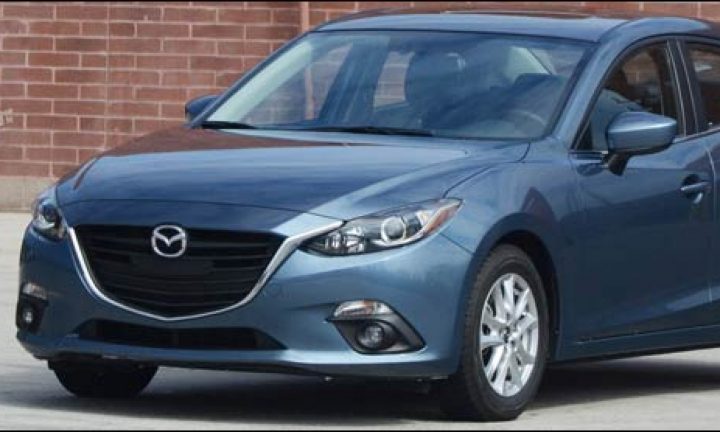
Known in most of the world as the Mazda Axela, the compact Mazda has that fine sense of being in touch with the road, without being punished by it; the engine balances acceleration with mileage nicely, and the light feel makes it a joy to drive.
Keeping things like banned acoustic glass and overdone sound insulation, so the Japanese sedan is noisier than some competitors, particularly with road noise, especially bearing the Blizzaks of our test car. Those also brought controllable, mild skids in some fast turns, which we believe would not happen (at least, not as often) with the stock tires. That’s not to say you should expect to be sliding all over the road; the handling is quite good. The ride is also comfortable, with broken roads well filtered.

The Mazda3 has been rightly praised for its fun factor, and it’s easy to drive, from the clutch to the steering. There’s even an indicator to tell you what gear you’re in, and what gear it wants you in (up or down). The engine is not as powerful as some competitors, but the light weight brings decent 0-60 times (around 7.6 seconds). The 2.5 liter “s” series pushes out 184 horsepower and 185 pound-feet of torque, if that’s not enough.

The engine was ready to rev from a start, so it was easy to drive gently or to sprint hard. The sound is light and somewhat whiney.
On the highway, you don’t get sudden power boosts, but if you drop two gears, you get a smooth, even acceleration (two seems to be the magic number between three, which mostly adds noise, and one, which doesn’t do much at all). At 65 mph, you won’t need to downshift much; the engine is already at 2,000 rpm or so. You do need the revs, though.

The Mazda was fine in highway cruising, taking hills without slowing down, partly because of the gearing; you get into sixth gear at around 40 mph, and just stay there unless you want to pass (or you’re going up hill at 40). That makes for more engine noise on the highway (that you won’t hear a lot of, due to the wind and road noise) and busy shifting around town. Cruising in top gear at 2,000 rpm (65 mph) doesn’t prevent EPA estimates of 41 highway, but the faster you go over 55, the less you should expect (e.g. at 75, you’re at around 2,800 rpm).
The automatic Mazda3 doesn’t feel quite as fast, but it’s theoretically just 0.1 seconds slower than the manual.

Its grip is amazing for an economy car, while the ride is generally smooth, despite that vibration coming from the road, which signals the surface to the driver and helps alertness. This is the “good” kind of vibration that most automakers filter out — and that was a hallmark of Chrysler in the 1990s, long lost. The Mazda3 rewards hard driving, but doesn’t demand it.
If you ask which I found most enjoyable to drive, slow or hard, it was the Mazda3; the Dart trailed this trio — though, by far, it had the best instrumentation and controls, with the fewest apparent bugs.
Odd controls
The tiny LED-bar tachometer is all the way off on the left, too small and drowned out by ambient light. The gauge cluster is small, except the oversized speedometer, which can’t be brightened enough during the day.

Mazda seems to have made design choices with the goal of being different, such as having the trip computer on the right and odometer on the left. Do most navigation systems have the controls on the dash? Mazda puts them on the center console. How about radios? Yes, check the center console…not the dash.
 The knob setup included a button in the middle of the knob itself, used as “enter;” a return/up button on the left, favorites on the right (if you press it while outside music or navigation, it takes you to a favorites folder); and home, music, and navigation buttons. You’ll get used to it. The radio on/off and volume are right next to it, a much smaller knob. The tactile feel of the big knob was quite nice; of the radio knob, not so much.
The knob setup included a button in the middle of the knob itself, used as “enter;” a return/up button on the left, favorites on the right (if you press it while outside music or navigation, it takes you to a favorites folder); and home, music, and navigation buttons. You’ll get used to it. The radio on/off and volume are right next to it, a much smaller knob. The tactile feel of the big knob was quite nice; of the radio knob, not so much.
HD radio traffic (not satellite traffic, apparently) is a separate map with no zooming at all and an almost useless scale — nice if you wonder if there’s traffic for your next two hours in Nebraska, overly cluttered if you want to know if you should avoid Newark for your 30-to-90 minute commute. The good side is that presumably there’s no annual fee; the bad side is it’s not very useful. The knob will take you up and down but not left and right, and, again, there’s no zooming, and it’s not integrated, as far as we could tell, with the navigation system.

The navigation system, while very fast, was deviated from custom without gaining much advantage. Changing the scale with the knob was nice.
The voice system worked well as did entering addresses with the knob and button (it also works by touch, but you never have to actually touch the screen, so it can stay clean). One big advantage over the Dodge and Volkswagen systems was oversized street names, easy to spot at a glance.

The stereo had good sound with the digital signal processor (optional on lower models); inputs included two different USB ports, making it easier to share a car (or use smaller drives). Using a USB thumb drive worked very well, but every couple of trips it reset either to the first song on the drive or the first song on the album, for no discernible reason.
The stereo also goes off when you turn off the car, though there is power memory for the center screen; and when you go to the accessory mode, it takes a while for the stereo to find its USB drive place. Once, the system locked up and wouldn’t accept input until the car was restarted (rebooted?).
The Mazda3 had few settings that could be changed by the driver, but it did have most of the majors, e.g. light delays, power lock actions, and such.

The best word for the climate control is “Gak!.” See if you can make sense of this. The whole thing is quite small and far from the driver. Mode is set by buttons — you cycle through vent positions (defrost does have its own button). Automatic goes on with a knob pushbutton, off with a small button in the “fake circle.” Temperature is set with knobs, good; fan speed is not. There are so many superior solutions out there to copy; the only thing this has going for it is having front and rear defroster next to each other.

The steering wheel buttons match that confusion. The “forward/backward” on the stereo sometimes didn’t work (perhaps it’s because sometimes the system went into repeat mode without any coaching). The cruise was more of an issue; having Cancel and Resume on the same button is a recipe for problems, and so is having Cancel on the far side of Resume so you have to reach over one oh-so-easy-to-press button to reach the other. It ended up being busy and crowded.

The backup camera is good during the day, combining a wide-range view on the sides with a sensible view of the area directly behind the car, but wasn’t bright enough at night.
Space and such
The trunk is nicely sized for a compact; seat release buttons are in the trunk but use easily caught cables which were loose in our test car (you can see one flopping around before I re-attached it).

The Mazda has more legroom and less interior width, which seems to come out of the center console rather than the seats. The result is that the center console is smaller, so you can’t put a full size box of tissues in.

The accent stitching thing is present on both cars, along with the “driver oriented” panel. You can see there’s plenty of room in both front and rear; and, like the Dart, the Mazda has those “shove the head forward” headrests.

The rear seats are comfortable and both cars have a cupholder/armrest that folds down from the middle. If you don’t like black or gray interiors, incidentally, the Mazda seems to have a beige option all through the line.

Those buttons on the left are shutoffs for safety systems and, below that, the trunk release button; below that the hood and gas-cap releases, in different sizes so you don’t pop the hood when trying to open the gas cap. The controls are not necessarily placed for actual use; it seems that the designers put some things wherever it would fit and others where they’d look best, not work best.
The center display/touch-screen looks like an add-on in the Mazda, but it works well, generally.
Pricing it out
Our test car was a Grand Touring i (i is the normal line, s is sport). It listed at $22,545, with the manual transmission. The Mazda line doesn’t have many options and packages; you get the level you want, and if you add to it, it usually comes out costing more than just getting the next model up. HID headlights are on the top model only.

The test car was second from top of the line, and had just a single option, a $70 cargo mat, topping out at $23,495 including destination; pay $2,000 more for the top of the line and you get HID lights and some other features. Standard items were rain-sensing wipers, heated mirrors with turn signals, fog lights, four-wheel disks, sunroof, heated “leatherette” seats (with power for the driver), dual-zone auto climate control, pushbutton start, seven-inch center touch-screen display, rear camera, navigation, Bose eight-speaker audio with signal processor, various audio software (Pandora, etc), two USB inputs, text message delivery and reply, cruise and trip computer, and audio controls on the wheel.

For safety, the car includes blind spot monitoring, rear cross path alert, hill launch assistance, roadside assistance, front side-impact airbags, and front and rear curtain airbags. The car is rated at five stars from the government for everything but front-crash on the passenger side (four stars) and rollover (four stars). The IIHS gave the Mazda3 top marks in every single category. It might be light, but it’s strong.

To wrap it up: the Mazda3 feels light, has decent acceleration, good economy, and a lot of interior space; it’s both fun and functional, despite the rather inane controls. It’s definitely on our shopping list.

David Zatz has been writing about cars and trucks since the early 1990s, including books on the Dodge Viper, classic Jeeps, and Chrysler minivans. He also writes on organizational development and business at toolpack.com and covers Mac statistics software at macstats.org. David has been quoted by the New York Times, the Daily Telegraph, the Detroit News, and USA Today.

Leave a Reply